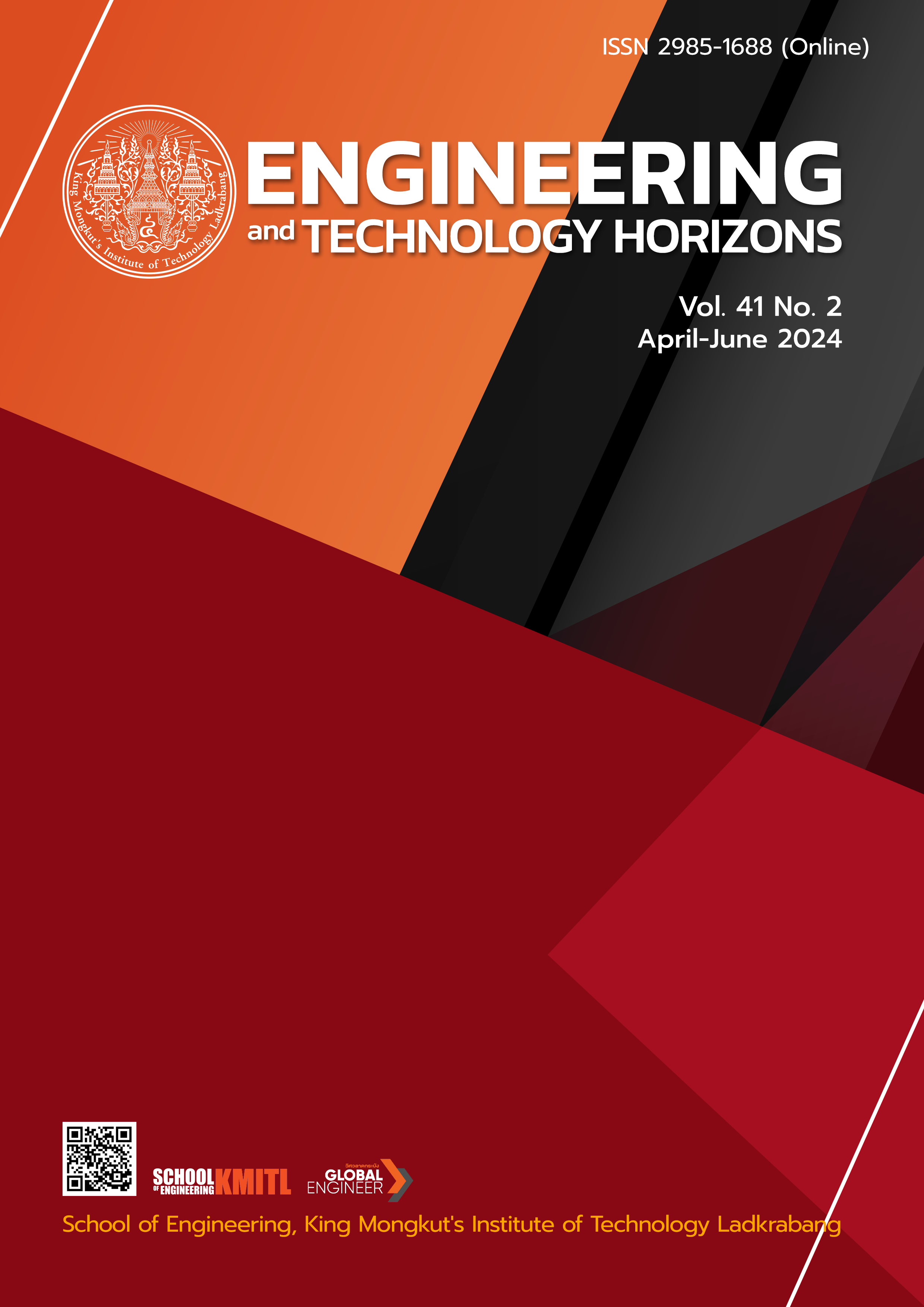Logistic Regression Analysis of Factors Affecting Robot Arm Movement Testing
DOI:
https://doi.org/10.55003/ETH.410209Keywords:
Improvement, Logistic regression, Operator performance, Robot arm movement test, Root cause analysisAbstract
Currently, with the rapid growth of robots in the industrial and service sectors, the robotic arm product is in high demand, and manufacturers need to deliver it on time. The manufacturer has a new product called “robot arm”. The issue is a high failure rate at the test station called the robot arm movement test. The manufacturer focused on the test process in order to reduce any variance that may result in a failure rate, with the operator's performance being their primary interest. Since the first group was built and tested, totaling 233 units of the robot arm, the logistic regression was applied with three independent variables. There are operators, working shifts, and product models. The results indicate day or night shifts are not related to the test failing. The operator and product model are important factors in the test failing. The 1.5–meter–long model has a higher chance of passing the test than the 1–meter–long model by about 13.66 times and the 2–meter–long model by 25.25 times. Operator D is the best at performing the robotic arm test and has a better chance of passing than the other operators (2.07 times for Operator A, 6.53 times for Operator B, and 7.01 times for Operator C). The action is that the software test needs to be updated for the 1– and 2–meter–long models. Moreover, Operators B and C need to be retrained as a priority. Then the manufacturer needs to focus more on the assembly process for yield improvement.
References
IFR. “World Robotics Report: All–Time High with Half a Million Robots Installed in One Year.” IFR.com. https://www.universal–robots.com/in/blog/robotic–arm/ (accessed Nov. 9, 2022)
S. E. Hashemi–Petroodi, S. Thevenin, S. Kovalev and A. Dolgui, “Operations management issues in design and control of hybrid human–robot collaborative manufacturing systems: a survey,” Annual Reviews in Control, vol. 49, pp. 264–276, 2020, doi: 10.1016/j.arcontrol.2020.04.009.
J. Holland, L. M. Kingston, C. Mccarthy, E. Armstrong, P. O'dwyer, F. Merz and M. McConnell, “Service Robots in the Healthcare Sector,” robotics, vol. 10, no. 47, 2021, Art. no. 47, doi: 10.3390/robotics10010047.
L. Gazzaneo, A. Padovano and S. Umbrello, “Designing Smart Operator 4.0 for Human Values: A Value Sensitive Design Approach,” Procedia Manufacturing, vol. 42, pp. 219–226, 2020, doi: 10.1016/j.promfg.2020.02.073.
K. Harish, D. Megha, M. Shuklambari, K. Amit and K. J. Chaitanya, “Pick and place robotic arm using Arduino,” International Journal of Science, Engineering and Technology Research (IJSETR), vol. 6, no. 12, pp. 1568–1573, 2017.
Y. Chen and F. Dong, “Robot machining: recent development and future research issues,” The International Journal of Advanced Manufacturing Technology, vol. 66, pp. 1489–1497, 2013, doi: 10.1007/s00170–012–4433–4.
R. Naboni, A. Kunic, A. Kramberger and C. Schlette, “Design, simulation and robotic assembly of reversible timber structures,” Construction Robotics, vol. 5, pp. 13–22, 2021, doi: 10.1007/s41693–020–00052–7.
C. Panyasai and R. Chockrungissaranukul. “Industrial Robot Programming.” nectec.or.th. https://www.nectec.or.th/news/news–public–document/industrial-robot-programming.html (accessed Dec. 15, 2022)
P. Michalik, V. Molnár, G. Fedorko, B. Stehlíková, P. Tirpák and J. Macej, “Research on the Influence of Production Technologies on the Positioning Accuracy of a Robotic Arm for Low–Handling Weights.” applied sciences, vol. 11, no. 13, 2021, Art. no. 6104, doi: 10.3390/app11136104.
F. E. Harrell, “Binary logistic regression,” in Regression modeling strategies, 2nd ed. Aargau, Switzerland: Springer International Publishing, 2015, ch. 10, sec. 10.1–10.13, pp. 219–274.
L. Niu, “A review of the application of logistic regression in educational research: Common issues, implications, and suggestions,” Educational Review, vol. 72, no. 1, pp. 41–67, 2020, doi: 10.1080/00131911.2018.1483892.
J. Phillips, E. Cripps, J. Lau and M. Hodkiewicz, “Classifying machinery condition using oil samples and binary logistic regression,” Mechanical Systems and Signal Processing, vol. 60–61, pp. 316–325, 2015, doi: 10.1016/j.ymssp.2014.12.020.
D. C. Montgomery, E.A. Peck and G.G. Vining, “Generalized linear model,” in Introduction to Linear Regression Analysis, 6th ed. Hoboken: John Wiley & Sons, 2021, ch. 13, sec. 13.2, pp. 441–462
E. O. Ogundimu, D. G. Altman and G. S. Collins, “Adequate sample size for developing prediction models is not simply related to events per variable,” Journal of Clinical Epidemiology, vol. 76, pp. 175–182, 2016, doi: 10.1016/j.jclinepi.2016.02.031.
F. Y. Hsieh, D. A. Bloch and M. D. Larsen, “A simple method of sample size calculation for linear and logistic regression,” Statistics in medicine, vol. 17, no. 14, pp. 1623–1634, 1998, doi: 10.1002/(sici)1097-0258(19980730)17:14<1623::aid-sim871>3.0.co;2-s.
C. F. Chien, C. W. Liu and S. C. Chuang, “Analysing semiconductor manufacturing big data for root cause detection of excursion for yield enhancement,” International Journal of Production Research, vol. 55, no. 17, pp. 5095–5107, 2017, doi: 10.1080/00207543.2015.1109153.
F. H. van Meulen, T. Vermaat and P. Willems, “Case Study: An Application of Logistic Regression in a Six Sigma Project in Health Care,” Quality Engineering, vol. 23, no. 2, pp. 113–124, 2011, doi: 10.1080/08982112.2011.553761.
N. Katemukda, “Applying the logistic regression for the quality of microelectronics product,” Journal of Applied Statistics and Information Technology, vol. 6, no. 2, pp. 25–35, 2021.
Downloads
Published
How to Cite
Issue
Section
License
Copyright (c) 2024 School of Engineering, King Mongkut’s Institute of Technology Ladkrabang

This work is licensed under a Creative Commons Attribution-NonCommercial-NoDerivatives 4.0 International License.
The published articles are copyrighted by the School of Engineering, King Mongkut's Institute of Technology Ladkrabang.
The statements contained in each article in this academic journal are the personal opinions of each author and are not related to King Mongkut's Institute of Technology Ladkrabang and other faculty members in the institute.
Responsibility for all elements of each article belongs to each author; If there are any mistakes, each author is solely responsible for his own articles.






